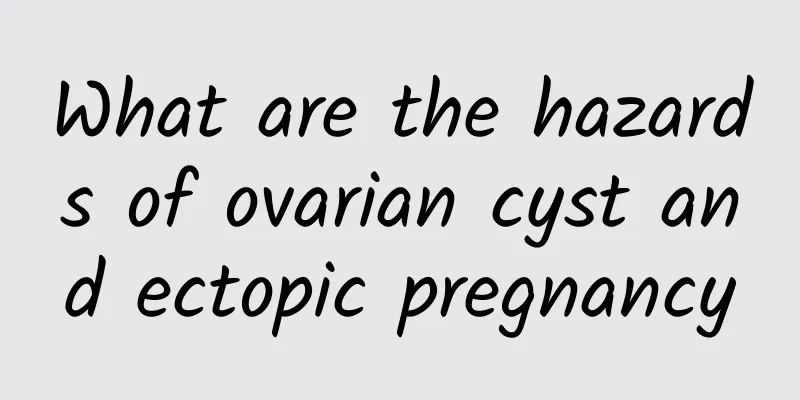What are the hazards of ovarian cyst and ectopic pregnancy

|
What are the dangers of ovarian cyst ectopic pregnancy? Ovarian cysts mainly occur in women after childbirth. They are a general term for true ovarian tumors and ovarian-like lesions. Gynecology points out that left tubal ampulla pregnancy is an ectopic pregnancy. Because the fallopian tube is not smooth, the fertilized egg cannot reach the uterus in time for implantation, and it has nothing to do with ovarian cysts. However, women with uterine fundus fibroids or ovarian cysts may also suffer from ectopic pregnancy due to the squeezing and traction of the tumor, the displacement of the uterus and fallopian tubes, and the change of the fallopian tube morphology, which hinders the normal implantation of the fertilized egg. The hazards of ovarian cysts are as follows: 1. Tumor pedicle torsion: When the tumor pedicle grows to the size of a fist or a fetal head, about 10% of ovarian tumors will torsion. Cystic teratomas, mucinous and serous cystadenomas are most likely to torsion. They may also rupture when turning over or intestinal peristalsis. 2. Ovarian cancer: Since the ovaries are located in the pelvic cavity, there are no symptoms in the early stage, and there is a lack of early diagnosis and identification methods. Once diagnosed as malignant, it is often an advanced cancer. Ovarian cysts can easily become enlarged, twisted, infected, bleeding or burst, posing a threat to the patient's life. The survival rate of ovarian cancer is the lowest. 3. Causes infertility: Ovarian cysts become larger or degenerate, causing sperm, eggs or fertilized eggs to not work normally, affecting fertility and leading to infertility. 4. Edema of the limbs: In addition to loss of appetite, weight loss, and abdominal distension, patients with ovarian cysts may also suffer from vomiting, fever, and abdominal pain; in the later stages, it may even lead to edema of the abdomen and limbs. 5. Rupture and rupture: The incidence of spontaneous cyst rupture is high. If the cyst ruptures or is squeezed, the viral fluid will flow into the patient's abdominal cavity, which can cause peritonitis, intestinal adhesions, and even intestinal obstruction, which is life-threatening. |
<<: What to do for Bartholinitis
>>: Causes of uterine fibroids
Recommend
What causes ovarian cysts? What can I do?
What causes ovarian cysts? What can I do? Ovarian...
Is cervical erosion hereditary?
Cervical erosion is a common gynecological diseas...
Is amenorrhea a symptom of irregular menstruation?
Amenorrhea is one of the symptoms of irregular me...
What are the factors that cause cervical hypertrophy?
What are the causes of cervical hypertrophy ? I b...
Lose weight, control appetite, and prevent calorie excess! 5 kinds of fruits to increase satiety and keep you slim
If you want to lose weight successfully, you must...
Multiple artificial abortions can cause cervical erosion
In life, many female friends will suffer from cer...
What medicine is good for cervical erosion
What medicine is good for cervical erosion? In fa...
Symptoms of uterine fibroids Are the symptoms of uterine fibroids obvious?
We should pay attention to abnormal menstruation,...
What health care measures should women take after abortion?
Women must not take it lightly after an abortion ...
What is ectopic pregnancy intervention? Advanced treatment methods
Interventional treatment for ectopic pregnancy is...
What are the symptoms of uterine fibroids? Can uterine fibroids cause bleeding?
Uterine fibroids are one of the most common benig...
What are the medical treatments for menopause?
As the pressure of life increases, women's li...
How to completely cure vaginal candidal infection
The treatment of candidal vaginitis needs to be t...
What are the causes of ectopic pregnancy?
Everyone must be unfamiliar with the term ectopic...
Dietary taboos that patients with vulvar leukoplakia should follow
Patients with vulvar leukoplakia should pay atten...









